Frontline report: Fierce battles rage as Russians attempt to cross Durna River in Avdiivka direction
Ukrainian forces swiftly dealt with three waves of Russian mechanized assaults, destroying at least 12 tanks and 8 infantry fighting vehicles, according to verified losses.
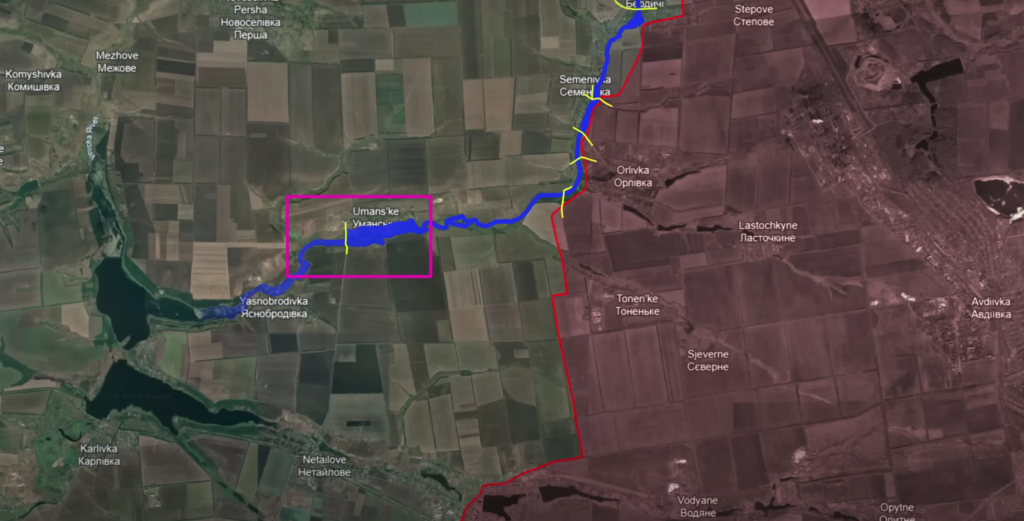
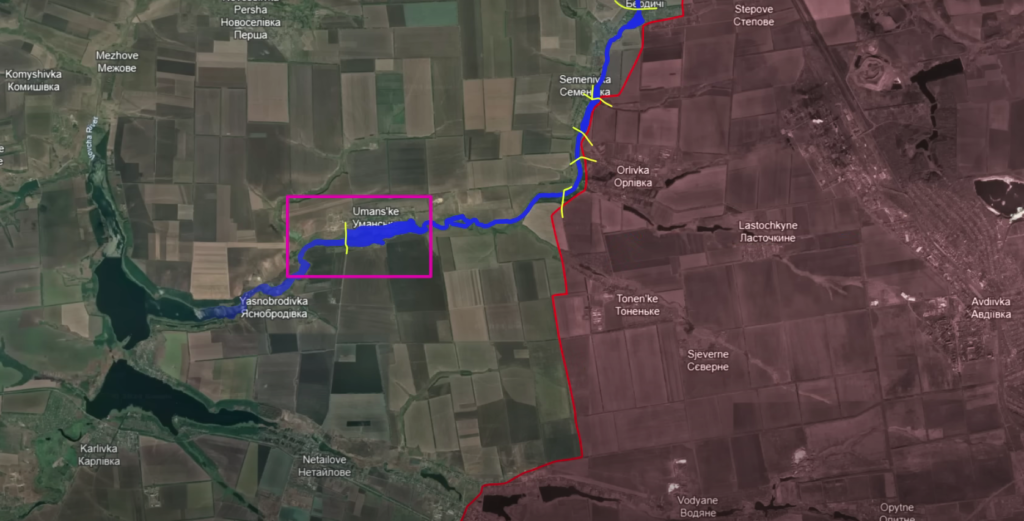
Day 778: 10 April
On 10 April, there is a lot of news from the Avdiivka direction.
Russians are attempting to breach the newly formed Ukrainian defense line and cross the Durna River. After the fall of Avdiivka, the Ukrainian city of Pokrovsk became the next main stronghold of Ukrainian forces in this direction.
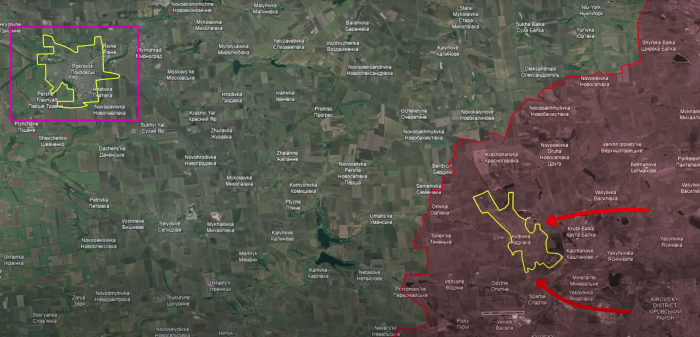
Pokrovsk is the main Ukrainian headquarters in the area, from which they reinforce, repair, and rotate their soldiers and equipment from the frontline. As such, Ukrainians have established multiple lines of defense to halt the Russian advance, if Russians do decide to make Pokrovsk their next main target. And it looks like the Ukrainians were right.
After slowly making their way through minefields and Ukrainian settlements behind Avdiivka, Russians have reached the first Ukrainian defensive line behind the Durna River. This river is too wide to cross in many places and, in some, has turned into a swamp.

Therefore, Russians are attempting to gain access to as many crossing points as possible to increase their chance of crossing the river and establishing a bridgehead. However, Russians do not control all crossing points, most importantly the one near Umanske, giving Ukrainians the possibility of conducting counterattacks on the exposed Russian flanks.
Geolocated footage confirms that Ukrainians launched multiple successful counterattacks on the Russian flanks near Tonenke, drone strikes on Russian armor stationed near the settlement, and on Russian positions in the Town itself.
These attacks forced Russians to take immediate action to prevent a possible collapse of their new offensive, as Russians launched a massive wave of attacks on the fields in front of Umanske.
The Institute for the Study of War noted that these waves of battalion-sized assaults are the largest since Russian forces began their campaign to seize Avdiivka in late October last year.
On the first day, Russians launched three waves of mechanized assaults. Russians launched their first wave early in the morning and attempted to cover their advance with smoke shells shot from their artillery.
They were assaulting positions manned by the Ukrainian 25th airborne brigade, who had received training from Western allies and were equipped with modern weaponry. As such, the Russian assault was swiftly dealt with.
The first Russian tanks were destroyed by Ukrainian T-80 tanks, and the Russian attack quickly dissolved into chaos as the rest were cleaned up by artillery, drones, and further tank fire. Later, Russians launched second and third waves, each consisting of 4 armored vehicles.
During these attacks, Ukrainians also utilized Western-made Javelin anti-tank missiles in addition to the already present Ukrainian tanks, artillery, and drones.
Despite losing a large amount of armored vehicles and infantry, Russians still managed to cross multiple fields, and take up positions in the tree lines. However, Ukrainians did not intend to allow Russians to establish a permanent hold here and conducted multiple swift counterattacks.
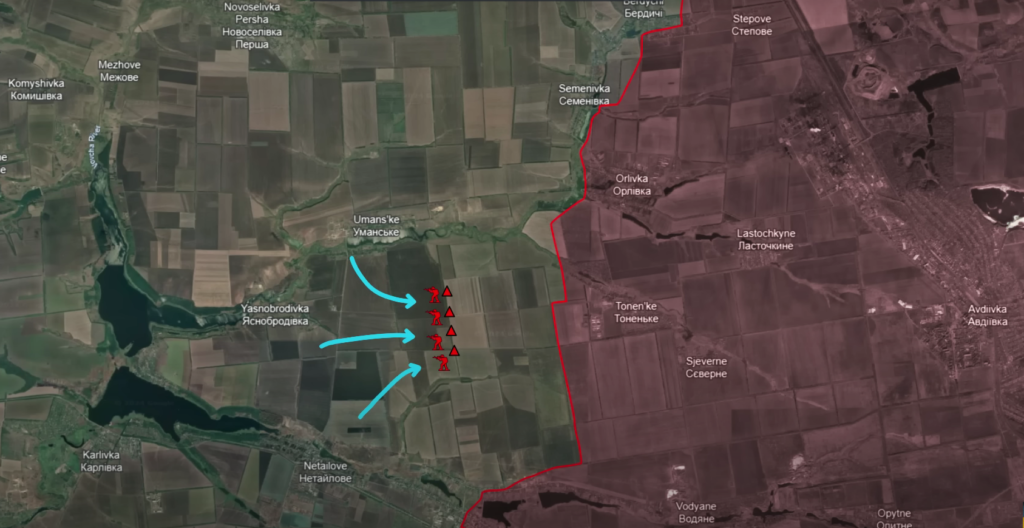
Russians did not expect a counterattack, and as such, the 25th airborne brigade utilized the element of surprise to eliminate the tired Russian formations, who had no possibility of retreat. All Russian armored vehicles were either destroyed or pulled back shortly after dropping off the infantry in order not to meet the same fate. As a result, the Russians were pushed back to square one.
A Ukrainian soldier active in the area stated that Russians committed over 36 tanks and 12 Infantry Fighting Vehicles to their first day of assaults alone. Counting only the number of verified, geolocated Russian equipment losses, Russians lost over a third of their armored vehicles, 12 tanks, and eight infantry fighting vehicles in just one day.
A Russian Storm-Z officer stated that they suffered from a lack of artillery and air support as the assault went on, which resulted in significant losses.
The Russian officer also stated that Russian forces could ultimately ‘overload’ the Ukrainian defenses, if only they could send forward more waves of armored assaults.
After the series of failed assaults, Russian aviation conducted an air strike with FAB-250 bombs on the Ukrainian dam and crossing point in the town of Umanske. At first glance, the Russian strike seems successful, as the road over the river was destroyed, cutting off the Ukrainian crossing point to the North.
However, we can see that the Ukrainian bridge to the south is still operational, including the larger crossing to the West, which is too large to be taken out by a single airstrike.
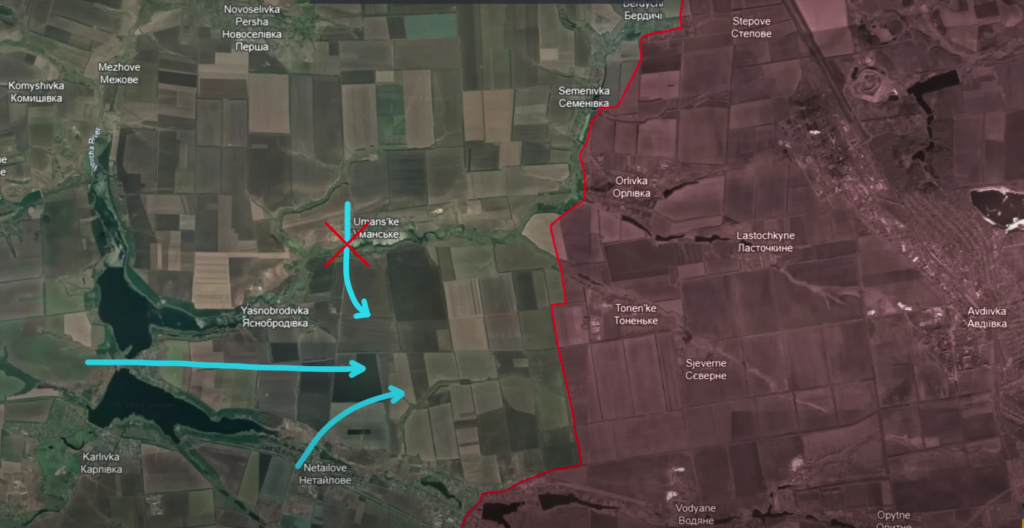
Shortly thereafter, Russians renewed their assaults in this direction. Russian forces also adapted to the Ukrainian drones. A Ukrainian military observer stated that during one assault, Russians had equipped their leading tank with new Electronic Warfare systems, which sever a drone operator’s connection to their drone, leading it to miss the target completely or crash into the ground.
Ukrainians could only defeat this tank after calling in a new variant of fixed-wing drone with a thermal targeting system built in.
Such targeting systems allow the drone to steer itself into the target, circumventing the Russian Electronic Warfare, as it does not need a connection to the operator to score a hit.
Overall, Russian forces have slightly advanced in the direction of Umanske, which was to be expected as Ukrainians lost their crossing point in the North.
A Russian officer stated that even though Russian forces had achieved some tactical successes, they lacked the coordination, artillery, Electronic Warfare, and engineering support needed to exploit these tactical successes into a large-scale operational breakthrough.
Furthermore, the Institute for the Study of War stated that Ukrainians demonstrated the ability to skillfully defend against such large-scale Russian assaults.
In the face of such significant challenges, this is a positive indicator of Ukraine’s ability to defend against future large-scale Russian assaults and the expected Russian summer offensive operation.
In our daily frontline report, we pair up with the military blogger Reporting from Ukraine to keep you informed about what is happening on the battlefield in the Russo-Ukrainian war.
Read also:
- Frontline report: Russia’s Kharkiv offensive rumors info-op, not genuine threat
- Frontline report: Ukrainian troops in Chasiv Yar face extensive bombing and numerous attacks
You could close this page. Or you could join our community and help us produce more materials like this.
We keep our reporting open and accessible to everyone because we believe in the power of free information. This is why our small, cost-effective team depends on the support of readers like you to bring deliver timely news, quality analysis, and on-the-ground reports about Russia's war against Ukraine and Ukraine's struggle to build a democratic society.
A little bit goes a long way: for as little as the cost of one cup of coffee a month, you can help build bridges between Ukraine and the rest of the world, plus become a co-creator and vote for topics we should cover next. Become a patron or see other ways to support.



